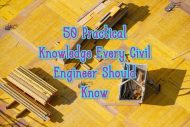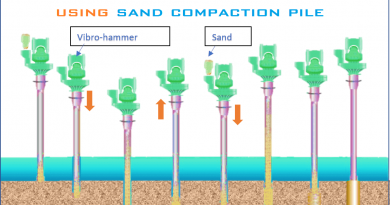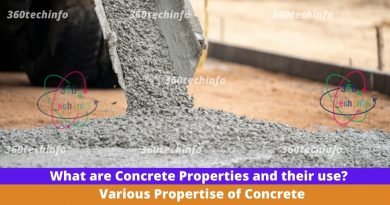50 Practical Knowledge Every Civil Engineer Should Know
50 Practical Knowledge for Civil Engineers, we are going to discuss 50+ Civil engineering Knowledge, which every civil engineer must have to know. In the daily work schedule, we civil engineers are facing many problems from lack of knowing very basic things. We are going to share with you those basic technical things in a bunch.
| 1. | What is the Height of a Single Storey Building? |
| Ans | 3.15 m |
| 2. | What is the volume of One bag cement? |
| Ans | 0.347 Cum or 1.25 Cubic feet. |
| 3. | What is the Weight of one bag cement? |
| Ans | 50 Kg |
| 4. | What is initial Setting time of Cement? |
| Ans | 30 min |
| 5. | Final Setting time of Cement for Ordinary Portland Cement is ? |
| Ans | 10 hours |
| 6. | What is the minimum nos of bar for a rectangular column? |
| Ans | 4 Nos |
| 7. | What is minimum nos of bar for circular column? |
| Ans | 6 Nos |
| 8. | What is the size of Concrete cube? |
| Ans | 150 x 150 x 150 mm |
| 9 | How much layer needs to fill a concrete cube for testing? |
| Ans | 3 layers |
| 10 | How much layer needs to fill a slump for slump test? |
| Ans | 4 Layers |
| 11. | What is the Validity of use of Cement? |
| Ans | It is 3 months from Manufacturing |
| 12. | For which test Universal Testing Machine is used? |
| Ans | Compression test of Concrete and Tensile test of reinforcement. |
| 13. | What is the minimum curing period for concrete? |
| Ans | In normal Weather, it is seven days. For Dry or Hot weather, it is 10 Days. |
| 14. | What is Deflection? |
| Ans | Deflection means temporary displacement |
| 15. | What is deformation? |
| Ans | Deformation is a permanent displacement. |
| 16. | What Is the formula for tensile strength of concrete? |
| Ans | 0.7 route fck |
| 17. | Which grade of concrete are called Ordinary Concrete? |
| Ans | M10 to M20 concrete are ordinary concrete. |
| 18. | Which grade of concrete are called Standard Concrete? |
| Ans | M25 to M35 |
| 19. | Which grade of concrete are called High Strength Concrete? |
| Ans | M60 to M80 |
| 20. | How much time required to mix concrete in a mixture machine? |
| Ans | Minimum 2-3 min needs to mix concrete in a mixture machine. |
50 Practical Knowledge for Civil Engineers In Hindi
| 21. | Which dia meter of bar should be used for Chairs? |
| Ans | Minimum 12 mm dia bar. |
| 22. | What is the Minimum Cover for Footing , Column, Slab and Beam? |
| Ans | Minimum cover should be: Footing-50 mm, Column-40 mm, Slab- 20 mm, Beam-25 mm |
| 23. | What is the ratio of most used cement concrete M10, M15, M20, M25? |
| Ans | For M10-(1:3:6), M15-(1:2:4), M20-1:1.5:3, M25-(1:1:2) The ratio is like Cement: Sand: Aggregates. |
| 24. | What is the minimum thickness of slab? |
| Ans | Minimum thickness of slab should be 125 mm |
| 25. | How much water absorption is allowed for brick? |
| Ans | Not more than 20 % |
| 26. | What is the minimum Diameter for dowels bar? |
| Ans | Minimum 12 mm dia bar. |
| 27. | What is the minimum allowable PH value of water? |
| Ans | It is not less than 6. |
| 28. | What is the lap length of bars for compression zone? |
| Ans | 24 d |
| 29. | What is the lap length of bar for M20 Grade Concrete? |
| Ans | For Column-45d, Beam-60d, Slabs -60d. |
| 30. | What is the lap length of bars for Tension zone? |
| Ans | 50d to 60 d, d=dia of bar. |
| 31. | What is Segregation of Concrete? and why its caused? |
| Ans | The separation of sand, cement, aggregates in concrete is called Separation of Concrete. Its caused due to improper water cement ratio. Also caused for poured above 1.5 height. |
| 32. | What is the storage procedure of Cement? |
| Ans | 1. Always store cement in a dry place. 2. Provide a gap of 300 mm from walls. 3. Never place cement bag direct in the floor always provide a 200 mm minimum height from floor. 4. Never put more than 10 nos of bag in a stack. 5. Keep in mind never make a cement storage near chemically effected floor or area and moisture effective area. |
| 33. | Calculations for no of stirrup in a abeam? |
| Ans | Clear Span/ c/c Spacing+1 |
| 34. | What is TMT? |
| Ans | Thermomechanical Treated Bar. |
| 35. | What is TMX? |
| Ans | Thermax Powered Bar. |
| 36. | What is SD? |
| Ans | Super Ductile Bars. |
| 37. | What is HYSD? |
| Ans | High Yield Strength Deformed Bars. |
| 38. | What is CTD? |
| Ans | Cold Twisted Deformed Bar. |
| 39. | What is the angle of staircase flight? |
| Ans | It is between 25 degree to 40 degree. |
| 40 | What is the minimum and maximum height of riser for residential building? |
| Ans | 150 mm to 200 mm |
| 41. | What is the minimum and maximum width of tread for residential building? |
| Ans | 250 mm to 300 mm |
| 42. | What is the minimum Hook length for bars? |
| Ans | It is 9D. (D-is dia of bar) |
| 43. | How much bricks needs for 1 Cum Brick of 230 mm brick wall /work? |
| Ans | 496 Nos |
| 44. | How much bricks need for 115 mm thk brick work? |
| Ans | 56 nos / Sqm |
| 45. | What is Bleeding in Concrete? |
| Ans | When water comes out from a just made concrete or fresh concrete then it is called bleeding of concrete |
| 46. | What is the maximum free fall for concrete? |
| Ans | Maximum allowable height of concrete free fall is 1.5 m. |
| 47. | What is the Angle of hook in stirrups? |
| Ans | 135 degree. |
| 48. | How much bars should be lapped in a bar bending zone? |
| Ans | Not more than 50% |
| 49. | What is the volume of one bag cement? |
| Ans | 0.0347 cum or 1.23 CFT |
| 50. | Calculations for weight of steel bars? |
| Ans | (D^2 xL)/162 |
Disclaimer- I am an amazon affiliate marketer. All given links in this post are for promoting amazon. Please ensure to buy something from Amazon






Very very useful,
Very useful and good information Sir
Thank you for helping.
Please keep posting more mathematical calculations used in civil construction filed.